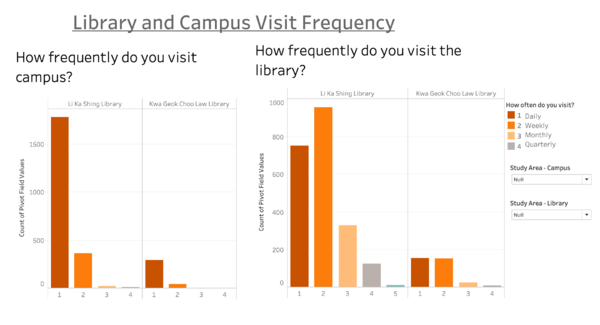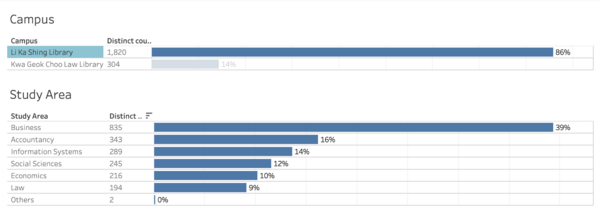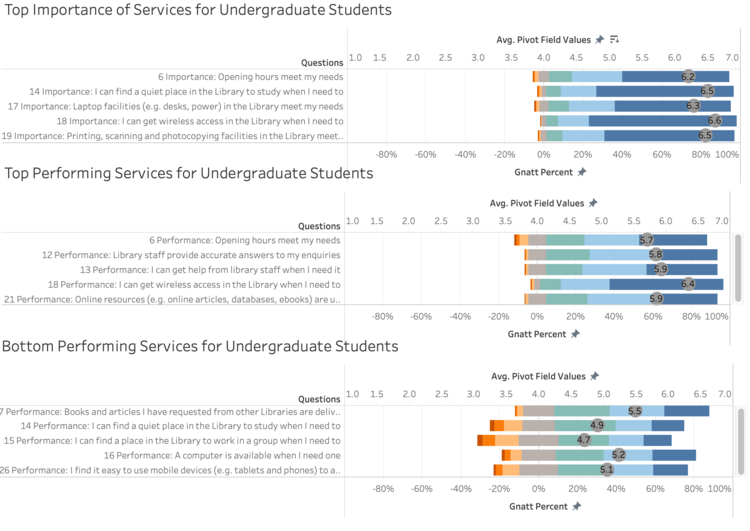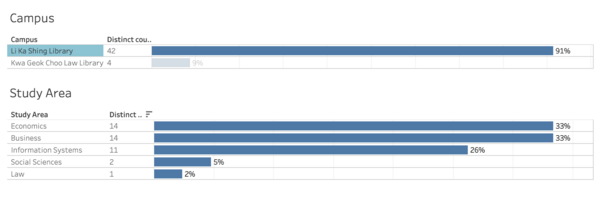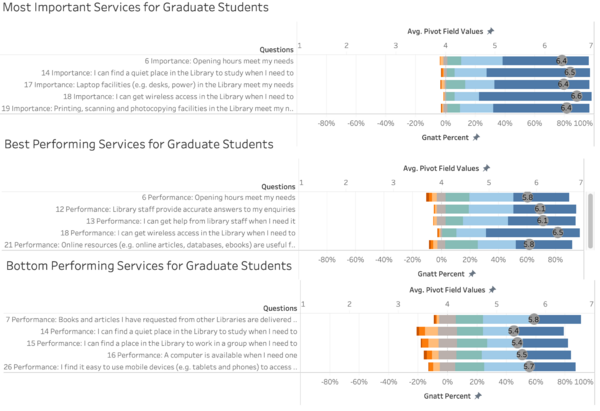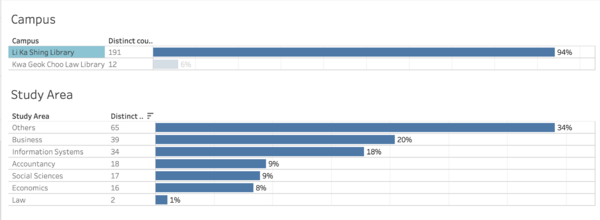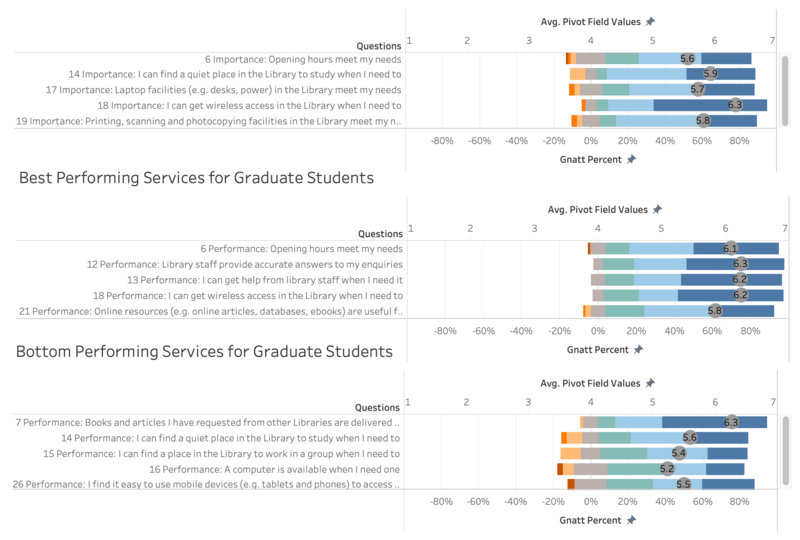Difference between revisions of "Analysis & Recommendations"
| Line 74: | Line 74: | ||
! Observations !! Recommendations | ! Observations !! Recommendations | ||
|- | |- | ||
| − | | All around, the survey respondents noted that they use Li Ka Shing Library at least 90% of the time. || This signifies that SMU Library Services should focus their improvement efforts on Li Ka Shing Library over Kwa Geok Choo Library. This | + | | All around, the survey respondents noted that they use Li Ka Shing Library at least 90% of the time. || This signifies that SMU Library Services should focus their improvement efforts on Li Ka Shing Library over Kwa Geok Choo Library. This allows SMU Library Services to have a greater overall impact on students/faculty's perception of library services. |
|- | |- | ||
| − | | Undergraduate, Graduate, and Faculty/Staff all signified the same most important services. This signifies that these are the factors that SMU Library Services should | + | | Undergraduate, Graduate, and Faculty/Staff all signified the same most important services. This signifies that these are the factors that SMU Library Services should focus improvements on. |
* Opening hours meet my needs | * Opening hours meet my needs | ||
* I can find a quiet place in the Library to study when I need to | * I can find a quiet place in the Library to study when I need to | ||
| Line 82: | Line 82: | ||
* I can get wireless access in the Library when I need to | * I can get wireless access in the Library when I need to | ||
* Printing, scanning and photocopying facilities in the Library meet my needs | * Printing, scanning and photocopying facilities in the Library meet my needs | ||
| − | || This signifies that there are several specific library services that students and staff care about and expect that SMU Library services deliver on. Because of the limited resources that SMU Libraries have, it will be important to allocate resources based off of what users determine are most important for them when they opt to utilize the Libraries at SMU. | + | || This signifies that there are several specific library services that students and staff care about and expect that SMU Library services deliver on. Because of the limited resources that SMU Libraries have, it will be important to allocate resources based off of what users determine are most important for them when they opt to utilize the Libraries at SMU. Those services are the ones highlighted to the left. Focusing on improving these services to meet the expectations of students first will prove to reap the most benefits for the library and those who use their services. |
|- | |- | ||
| − | | Each subgroup signified that the most important factor when using the library services is that they can access wireless service when they need to. Undergraduate and graduate students ranked it as a 6.6 average and faculty and staff ranked it as a 6.3 out of 7 importance. Similarly, this question ranked high on the performance scale as well. || While SMU Library services is currently performing well on the ability to deliver wireless access to students when needed, it is important for them to note that this will continue to be a service that they need to deliver on. Therefore, it is suggested that SMU Library Services are proactive in continually updating wireless access throughout the entire library system, but especially in Li Ka Shing Library because that is where a majority of respondents signified | + | | Each subgroup signified that the most important factor when using the library services is that they can access wireless service when they need to. Undergraduate and graduate students ranked it as a 6.6 average and faculty and staff ranked it as a 6.3 out of 7 importance. Similarly, this question ranked high on the performance scale as well. || While SMU Library services is currently performing well on the ability to deliver wireless access to students when needed, it is important for them to note that this will continue to be a service that they need to deliver on. Therefore, it is suggested that SMU Library Services are proactive in continually updating wireless access throughout the entire library system, but especially in Li Ka Shing Library because that is where a majority of respondents signified they utilize library services. Proactive approaches to ensure that this continues to be a a top performing service include activities such as updating routers to service every corner of the library and purchasing the latest speeds. |
|- | |- | ||
| One of the highest ranking questions on the importance factor, "I can find a quiet place in the library to study when I need to" also ranked in the bottom 5 performing services for undergraduate, graduate, and faculty/staff. On average, this question fell .5 below what is expected.|| It is noted that when students look to utilize SMU Libraries, they are presumably looking for a place to study and work on assignments. Currently, this expectation is not being met. Therefore, it is suggested that SMU Libraries, and specifically Li Ka Shing Library, look to provide students with an increased number of quiet study areas. This can be completed in a variety of ways. One, they can simply put aside more quiet only study spaces in the library. This would expand the areas where there is no talking or group work allowed. Additionally, SMU Library Services could look to create more private spaces. This could include more individual desks and blocked off tables to mitigate sound travel. It is noted that this method of providing more quiet spaces is costly and should be further explored before high investments are made. | | One of the highest ranking questions on the importance factor, "I can find a quiet place in the library to study when I need to" also ranked in the bottom 5 performing services for undergraduate, graduate, and faculty/staff. On average, this question fell .5 below what is expected.|| It is noted that when students look to utilize SMU Libraries, they are presumably looking for a place to study and work on assignments. Currently, this expectation is not being met. Therefore, it is suggested that SMU Libraries, and specifically Li Ka Shing Library, look to provide students with an increased number of quiet study areas. This can be completed in a variety of ways. One, they can simply put aside more quiet only study spaces in the library. This would expand the areas where there is no talking or group work allowed. Additionally, SMU Library Services could look to create more private spaces. This could include more individual desks and blocked off tables to mitigate sound travel. It is noted that this method of providing more quiet spaces is costly and should be further explored before high investments are made. | ||
|- | |- | ||
| − | | All around, Faculty/Staff signified that SMU Library Services were meeting their needs whereas undergraduate and graduate students signified that they were not. || Because it was shown that SMU Library Services are not meeting the needs of undergraduate/graduate students but are of faculty/staff, SMU Libraries should focus their improvement efforts on undergraduate/graduate students. This can be better targeted through another focused survey that | + | | All around, Faculty/Staff signified that SMU Library Services were meeting their needs whereas undergraduate and graduate students signified that they were not. || Because it was shown that SMU Library Services are not meeting the needs of undergraduate/graduate students but are of faculty/staff, SMU Libraries should focus their improvement efforts on undergraduate/graduate students. This can be better targeted through another focused survey that pinpoints more specific needs of undergraduate and graduate students. For example, SMU Library Services can focus the new questions on the bottom performing services to better understand what students are looking for. |
|- | |- | ||
| One of the lowest ranking services is "a computer is available when I need one". || SMU Libraries should focus in on ways that can make more laptops available for more people to use. This can be achieved through setting limits on when and how long students can use laptops for. Another alternative would be to purchase and provide more laptops for students to use. It is noted that this recommendation is expensive and may have a limited impact. However, it could be the step in the right direction to continually meet the needs of SMU Library Service users. | | One of the lowest ranking services is "a computer is available when I need one". || SMU Libraries should focus in on ways that can make more laptops available for more people to use. This can be achieved through setting limits on when and how long students can use laptops for. Another alternative would be to purchase and provide more laptops for students to use. It is noted that this recommendation is expensive and may have a limited impact. However, it could be the step in the right direction to continually meet the needs of SMU Library Service users. | ||
|- | |- | ||
| − | | While finding wireless access was deemed as a higher performing service, finding it easy to use a mobile device was one of the lowest performing services. || SMU Library Services should work to promote best practices when it comes to using a mobile device in the library. This can be achieved through an ad campaign that highlights steps to take to best utilize your mobile device, such as booking a study room or finding a book. Educating students and faculty/staff how to do that will boast confidence in mobile device services in SMU Libraries. | + | | While finding wireless access was deemed as a higher performing service, finding it easy to use a mobile device was one of the lowest performing services. || SMU Library Services should work to promote best practices when it comes to using a mobile device in the library. This can be achieved through, for example, an ad campaign that highlights steps to take to best utilize your mobile device, such as booking a study room or finding a book. Educating students and faculty/staff how to do that will boast confidence in mobile device services in SMU Libraries. |
|} | |} | ||
== Special Considerations == | == Special Considerations == | ||
It is important to note that survey's have limitations in on the data and insights captured. It is possible that the survey results are not conducive of the student and faculty population. However, with the number of respondents, this survey can be concluded as statistically significant. Therefore, the insights extrapolated are concluded to be worthy of action steps. It is recommended that if SMU Library Services wishes to take extensive steps, such as large investments, that more focused data should be collected to ensure that the right services are being targeted. | It is important to note that survey's have limitations in on the data and insights captured. It is possible that the survey results are not conducive of the student and faculty population. However, with the number of respondents, this survey can be concluded as statistically significant. Therefore, the insights extrapolated are concluded to be worthy of action steps. It is recommended that if SMU Library Services wishes to take extensive steps, such as large investments, that more focused data should be collected to ensure that the right services are being targeted. | ||
Latest revision as of 23:09, 22 March 2020
Contents
Analysis & Final Recommendations
To showcase the survey results, an interactive dashboard was created and shared on Tableau Public. The final is attached here.
Visit Frequency
| Campus and Library Visit Frequency | Analysis |
|---|---|
| This visualization highlights that SMU students and faculty frequently, weekly, utilize SMU Library Services. Knowing this, it can be inferred that respondents of this survey often run into the services that they deem to be both good and poor performing because they are using the library services at least once a week. |
Undergraduate
Demographics
| Demographics | Analysis |
|---|---|
| As highlighted, the majority of undergraduate respondents prefer the Li Ka Shing Library (86%) to Kwa Geok Choo Law Library (16%). Furthermore, business students filled out the survey at least twice as much as compared to other areas of study. The following areas are Accounting and Information Systems who make up 16% and 14% of respondents. It will be important to keep these demographics in mind as we walk through the analysis as the data is skewed in favor of these groups. |
Analysis
To focus the analysis to highlight which areas SMU Libraries are doing well and areas that could be improved. Highlighted are the matches between the importance factors and how it ranked against the top and bottom 5 responses. For the purpose of this analysis, importance factors are to be compared against bottom and top performers. Doing this focuses SMU Library Service resources towards service with high expectations that are not being met.
Right away, it is noticed that two importance factors: "Opening hours meet my needs" and "I can get wireless access in the library when I need to", both made it on the top five for performance. However, it is shown that the average score on performance is lower than the average score for importance, especially for “opening hours meet my needs” who’s average performance score is 0.5 points lower than the importance score. This indicates that while the library is doing an overall good job with that metric, that they could look to do further research with students and faculty to understand why the performance score isn’t quite meeting the importance score and adjust as necessary.
Additionally, in this visualization we see that one of the lowest performing services, “I can find a quiet place in the library to study when I need to” is also in the top 5 for most important services for undergraduate students. This indicates that this service is not being met by SMU Libraries and should therefore be further explored. High level recommendations to improve this service are provided below. It is also important to note for this metric specifically is a poor performing for undergraduate, graduate, and faculty members. Again, this indicates to SMU Library Services that they are across the board under performing on this service.
Graduate
Demographics
| Demographics | Analysis |
|---|---|
| As highlighted, the majority of graduate respondents prefer the Li Ka Shing Library (91%) to Kwa Geok Choo Law Library (9%). Furthermore, economics and business students filled out the survey much more than the other areas of study. It will be important to keep this in mind as we walk through the analysis as the data is skewed in favor of these groups for graduate students. |
Analysis
To focus the analysis to highlight which areas SMU Libraries are doing well and areas that could be improved. Highlighted below you can see the matches between the importance factors and how it ranked against the top and bottom 5 responses for Graduate Students.
Here, we see that Graduate students have the same top 5 in each category as undergraduate students. Right away this signifies that the requirements and opinions of students are not bounded by their position in school. It is noted that the average score of each response varies a little. For example, the importance factor, “Opening hours meet my needs” ranked on average .2 higher for undergraduate students than graduate students. This could be because graduate students often have classes at “off” times, such as on weekends, as compared to undergraduate students. This means that their ability to get into the library when graduate students are already on campus may be more difficult. With that being said, you do see that SMU Libraries scored relatively high on this question’s performance. However, it is important to note that while it was high scoring relative to other performance factors, it still scored an average of .6 lower than the importance of that factor. Again, this could indicate that expectations are not being meet for this factor. This is obviously similar for the other top 4 most important factors who did not make it on the top 5 performing list. This indicates that expectations are not being meet for:
- Library staff provide accurate answers to my inquiries (12)
- I can get help from library staff when I need it (13)
- I can get wireless access in the Library when I need to (18)
- Online resources (e.g. online articles, databases, ebooks) are useful for my studies and help me with my learning and research needs (21)
Again, this indicates to SMU Library Services that students’ expectations of their services are not being met. This signifies that SMU Library Services are under performing on what is most important to students. It is also important to note that one of the most important factors, “I can find a quiet place in the library to study when I need to” was one of the bottom performing services for graduate students with an average score of 5.4 and is the service with the highest percentage of low scores. However, it can be noted that all of the bottom performing services are still skewed towards the positive response, meaning that overall SMU Library Services are doing well for Graduate students.
Faculty and Staff
Demographics
| Demographics | Analysis |
|---|---|
| As highlighted, the majority of faculty and staff respondents prefer the Li Ka Shing Library (94%) to Kwa Geok Choo Law Library (6%). It is noted that this is the highest skew of respondents for Li Ka Shing Library, signifying that it is overwhelming the preferred choice when using the library services at SMU. Furthermore, the area of study that was most prominent for this group is "other". This could signify that services for this group need to be more specialized because they do not fall into the typical area of study that undergraduate and graduate students typically fall into. It will be important to keep this in mind as we walk through the analysis as the data is skewed in favor of these groups. |
Analysis
To focus the analysis to highlight which areas SMU Libraries are doing well and areas that could be improved. Highlighted below you can see the matches between the importance factors and how it ranked against the top and bottom 5 responses for Graduate Students.
Right away when comparing the results of undergraduate students and graduate students to faculty and staff, we that the overall library service performance is considerably higher. For example, we see that the top 5 importance factors are almost all meeting the expectations of faculty and staff. This is very important because it highlights that SMU Library Services are all around meeting the expectations of faculty and staff. Because of this, it is suggested that SMU Library Services focus resources and service improvement on undergraduate and graduate students to bring their net promoter scores to that of equal or higher to faculty/staff.
Recommendations
Based on the comprehensive data visualization and analysis, there are several key recommendations on how SMU Library Services can best meet the needs and expectations of students and faculty.
| Observations | Recommendations |
|---|---|
| All around, the survey respondents noted that they use Li Ka Shing Library at least 90% of the time. | This signifies that SMU Library Services should focus their improvement efforts on Li Ka Shing Library over Kwa Geok Choo Library. This allows SMU Library Services to have a greater overall impact on students/faculty's perception of library services. |
Undergraduate, Graduate, and Faculty/Staff all signified the same most important services. This signifies that these are the factors that SMU Library Services should focus improvements on.
|
This signifies that there are several specific library services that students and staff care about and expect that SMU Library services deliver on. Because of the limited resources that SMU Libraries have, it will be important to allocate resources based off of what users determine are most important for them when they opt to utilize the Libraries at SMU. Those services are the ones highlighted to the left. Focusing on improving these services to meet the expectations of students first will prove to reap the most benefits for the library and those who use their services. |
| Each subgroup signified that the most important factor when using the library services is that they can access wireless service when they need to. Undergraduate and graduate students ranked it as a 6.6 average and faculty and staff ranked it as a 6.3 out of 7 importance. Similarly, this question ranked high on the performance scale as well. | While SMU Library services is currently performing well on the ability to deliver wireless access to students when needed, it is important for them to note that this will continue to be a service that they need to deliver on. Therefore, it is suggested that SMU Library Services are proactive in continually updating wireless access throughout the entire library system, but especially in Li Ka Shing Library because that is where a majority of respondents signified they utilize library services. Proactive approaches to ensure that this continues to be a a top performing service include activities such as updating routers to service every corner of the library and purchasing the latest speeds. |
| One of the highest ranking questions on the importance factor, "I can find a quiet place in the library to study when I need to" also ranked in the bottom 5 performing services for undergraduate, graduate, and faculty/staff. On average, this question fell .5 below what is expected. | It is noted that when students look to utilize SMU Libraries, they are presumably looking for a place to study and work on assignments. Currently, this expectation is not being met. Therefore, it is suggested that SMU Libraries, and specifically Li Ka Shing Library, look to provide students with an increased number of quiet study areas. This can be completed in a variety of ways. One, they can simply put aside more quiet only study spaces in the library. This would expand the areas where there is no talking or group work allowed. Additionally, SMU Library Services could look to create more private spaces. This could include more individual desks and blocked off tables to mitigate sound travel. It is noted that this method of providing more quiet spaces is costly and should be further explored before high investments are made. |
| All around, Faculty/Staff signified that SMU Library Services were meeting their needs whereas undergraduate and graduate students signified that they were not. | Because it was shown that SMU Library Services are not meeting the needs of undergraduate/graduate students but are of faculty/staff, SMU Libraries should focus their improvement efforts on undergraduate/graduate students. This can be better targeted through another focused survey that pinpoints more specific needs of undergraduate and graduate students. For example, SMU Library Services can focus the new questions on the bottom performing services to better understand what students are looking for. |
| One of the lowest ranking services is "a computer is available when I need one". | SMU Libraries should focus in on ways that can make more laptops available for more people to use. This can be achieved through setting limits on when and how long students can use laptops for. Another alternative would be to purchase and provide more laptops for students to use. It is noted that this recommendation is expensive and may have a limited impact. However, it could be the step in the right direction to continually meet the needs of SMU Library Service users. |
| While finding wireless access was deemed as a higher performing service, finding it easy to use a mobile device was one of the lowest performing services. | SMU Library Services should work to promote best practices when it comes to using a mobile device in the library. This can be achieved through, for example, an ad campaign that highlights steps to take to best utilize your mobile device, such as booking a study room or finding a book. Educating students and faculty/staff how to do that will boast confidence in mobile device services in SMU Libraries. |
Special Considerations
It is important to note that survey's have limitations in on the data and insights captured. It is possible that the survey results are not conducive of the student and faculty population. However, with the number of respondents, this survey can be concluded as statistically significant. Therefore, the insights extrapolated are concluded to be worthy of action steps. It is recommended that if SMU Library Services wishes to take extensive steps, such as large investments, that more focused data should be collected to ensure that the right services are being targeted.
